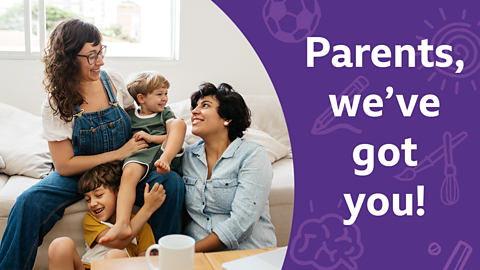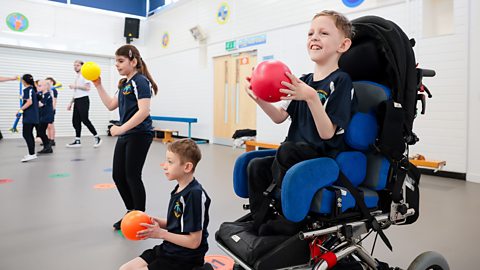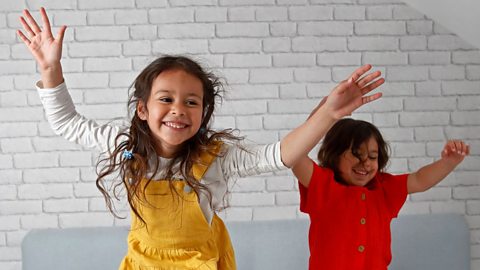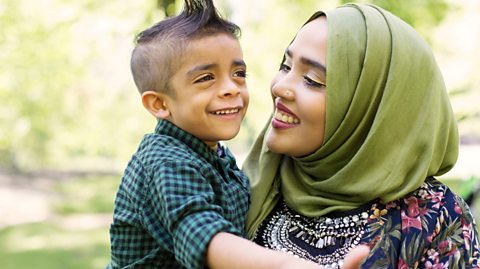
Over the summer, parents may worry that their child is missing out on exercise because school sport classes aren't running. But they can still get active - Super Movers for Every Body is an exciting initiative from the ±«Óătv, Premier League and ParalympicsGB to get everyone moving. It was designed for teachers and schools - but that doesn't mean each activity canât be adapted at home.
So when the summer holidays hit, parents donât need to panic. The items you need to keep up boccia, blind football or Para athletics are all around the house. And this goes for any sport and activity, there are so many ways to enjoy an active lifestyle for all the family - and disabled and non-disabled children can play these games together. With a few simple tweaks, activities can quickly become a part of everyone's daily routine.
With a brilliant summer of Paralympic sport ahead there's sure to be some added excitement around trying out new activities. With a little imagination, you will find solutions to play at home wherever you look - here are some tips from our partners at Activity Alliance:

How do I adapt sports to play at home with my child?
There are many ways to adapt activities so more people can move more in their home or garden. The STEP tool, designed by the Youth Sport Trust, is one of the most effective ways to use household items to be active.
What is the STEP tool?
STEP stands for Space, Task, Equipment and People.
- SPACE - adapt the space you and your children have to play in (the size, width, length) to make the task easier and harder, depending on their ability.
- TASK - adapt the task for your child to enjoy to ensure it is age-appropriate and challenging yet achievable.
- EQUIPMENT - explore changing the size, shape and weight of equipment, or change the purpose of equipment to achieve different results.
- PEOPLE - People can be included in games in lots of different ways: as partners, team members, or oppositions! If your child finds an activity easier or harder, you can adapt the role of other people to encourage them to set new goals.
STEP is a simple way for making changes to activities. It's commonly used in PE and school sport settings so that everyone can join in and take part together. But the principles work in all settings, especially in the home.
One thing to remember, anything goes when adapting activities in your home. There are no wrong answers as to what a blind football ball has to be, we all have bits and bobs lying around our homes, so why not get creative and give it a go.
What is blind football and how can my child play it at home?

England's women's blind football squad explain what blind football is
Blind football is an exciting sport where players wear blindfolds and use their listening skills to locate a ball fitted with internal bells to shoot into a goal. It is played in teams of five (four blindfolded outfield players and one sighted goalkeeper). A match is played in two halves of 20 minutes, and the aim of the game is to score more goals than the other team. Learning blind football creates an even playing field for players regardless of their sight. It also helps them enhance their listening skills.
Blind football players need to have good listening and communication skills and be fast. You might also think they need a large pitch to play on, but the reality is that you can set up a game at home with some simple equipment adaptations.
Learn how to play blind football.
Blindfolds can be fashioned out of scarves, clothes and towels. As for the ball, it needs to be audible but can be anything that can make a noise and roll. For example, a beach ball or clear plastic ball (used for sweets or toys) filled with dried rice or pasta, foil rolled-up into a ball or even rolled up socks with a bell in the middle.
You donât need to invest in cones as markers for goalposts, there are plenty of options in your wardrobe. Use clothes, shoes or blankets. Books and tin cans also make excellent goalpost markers. Just make sure to play somewhere free of obstacles and trip hazards.

What is boccia and how can my child play it at home?

Claire Taggart, two-time Paralympian and gold-medal winning World Champion, explains what boccia is
Boccia (pronounced âbot-chaâ) is the fastest growing disability sport in the world. It is one of the most inclusive sports and can be adapted to wherever you have space to play. Boccia is a target ball sport similar to bowls, played from a seated position. It is a game of two sides played indoors. Like bowls, the aim of the game is to get your ball closer to the jack than your opponent. The ball can be thrown, kicked, or rolled down a ramp onto the court. Players with significantly reduced mobility are allowed an assistant to help them place the ball. This is how it is played in the Paralympics!
Start by finding something to sit on, this doesnât have to be anything special, the sofa or kitchen chairs will be perfect. And whilst most games are played using chairs, sitting on the floor works just as well.
For the balls, a selection of any balls lying around the house will do or try rolled up socks. Just bear in mind that different colours or pattens will be needed for a team game. A long piece of folded cardboard, piece of outside guttering or cardboard tube will make a brilliant ramp. And the good news is that the markers you used for blind football will work just as well for boccia. You could also use plastic cups, string, pillows, cushions, or different sizes of paper with 10 (for a smaller target), four and two written on them for points.

How can my child play Para athletic sports at home?

Paralympians Hollie, Funmi and Thomas share their experience of Paralympic sports
One thing that will play a major part in the Paralympics will be the Para athletics. The javelin, track and shot put are events that can easily be replicated at school or at home.
For guided running you can use many of the same items you have used for blind football and boccia. You need a large safe area like a garden, driveway/yard (safe from moving vehicles), or local park. Place down clothes, shoes, books, tin cans or plastic cups as markers. Then use scarves, clothes, or towels as blindfolds. You then have everything you need for a race! Just make sure your guides are there to ensure the blindfolded runners donât trip or fall!
Javelin at home might sound terrifying, but the last thing being thrown around will be a real javelin. Reach for a garden cane (1m in length) with cotton wool sellotaped to the end. Four kitchen roll tubes taped together are also a brilliant alternative.
Host your own shot put competition and use plastic bags, socks, tights or gloves filled with dried rice or pasta to make a perfect shot put.

With every adaptation it is great to use different textures and tactile objects to experiment across activities. Different sizes, shapes and weight of objects also add another element.
The reality is that parents and children can try out every sport with very little equipment. Donât forget STEP - Space, Task, Equipment, People. With a few simple changes you will have hours of active fun!
have more information on opportunities for disabled people to be active and be more involved in sport and activity.
developed the STEP model and aim to improve young people's health and wellbeing through sport and play.

More from ±«Óătv Bitesize Parents' ToolkitâŠ
Parents' Toolkit
Fun activities, real-life stories, wellbeing support and loads of helpful advice - we're here for you and your child.

What are the benefits of inclusive sport for my disabled child?
How taking part in sport and accessing clubs can help children with disabilities to thrive.

How physical activity can support children with special educational needs and disabilities at home
Looking for ways to encourage your child to get active at home? Dr Anthony J. Maher has five tips.

What is a school SENCO?
Parents' Toolkit guide to the role of a Special Educational Needs Coordinator, what questions to ask a SENCO, and how can a SENCo help my child?

Seven ways to support your child with SEND at school
Dr Anne Emerson, Associate Professor in Special and Inclusive Education, provides tips on how to help support your child during their time at school.

What is an EHC plan and how do I get one for my child?
Parents' Toolkit guide to a Education, Health and Care plan, how to get an EHC plan for your child and what to do if your child canât get an EHC plan.
